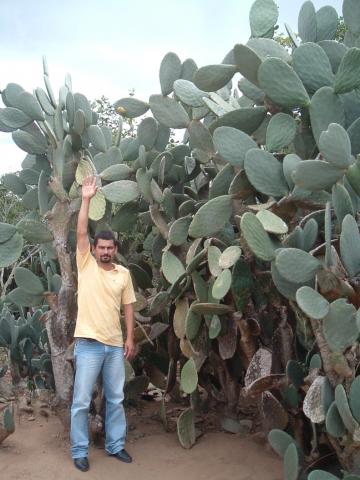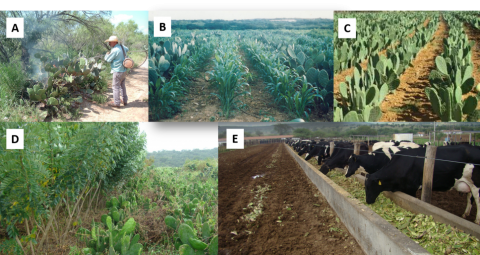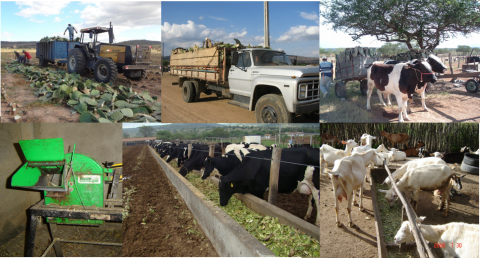Cactus: a crop for the dry areas
By Jose C. B. Dubeux Jr., University of Florida, North Florida Research and Education Center, USA
Introduction
Drylands comprise 40% of global land area and host more than two billion people (UNSO/UNDP, 1997). Drylands will play an increasing role in feeding the world in the upcoming years. Global human population is expected to reach 9.2 billion by 2050 and most of the increase will occur in the least developed countries (Dubeux et al., 2011). Drylands are overpopulated in most of the cases, increasing the pressure on natural resources. Agriculture has expanded its area in the last decades and the arid and semiarid regions are perhaps the last frontier. Together, arid and semiarid regions represent 30% of global land area. In these areas, availability and quality of water and soil restrict the use of irrigation. Harvesting annual cash crops in the arid and semiarid environments is risky. Seasonal and yearly fluctuation of rainfall severely reduces the potential of crops such as maize and beans. Perennial adapted crops are the best alternative to produce food for humans and feed for livestock.
Rangelands in semiarid regions are usually the basis for livestock production systems. Rangeland productivity is usually low (< 5 t dry matter (DM) ha-1 yr-1), with low forage potential (< 1 t DM ha-1 yr-1 of consumable forage), leading to low carrying capacity (12-15 ha to sustain an adult cow) (Dubeux et al., 2015). Global livestock population is increasing steadily in the past decades and, in some cases, leading to rangeland degradation. Water is another important limiting factor in drylands. Global projections of water use demonstrate increasing withdraws in the next decades, limiting its use for agriculture and livestock production. In this scenario, spineless cactus, more specifically Opuntia and Nopalea, become one of the most prominent crops for the 21st Century. Cactus has potential to produce > 20 t DM ha-1 yr-1 and provide 180 t ha-1yr-1 of fresh good-quality water stored in the cladodes for the livestock (Dubeux et al., 2015). This productivity is enough to produce forage to sustain five adult cows per year, at least 60-fold increase over the rangeland productivity. Thus, with small intensively cropped cactus orchards, it is possible to produce feed and lower the stocking rate from overstocked rangelands, reducing their degradation. The potential of cactus, however, is still underexploited. All the estimated cropped area with cactus does not reach 0.1% of the dryland area dedicated to grasslands.
Figure 1. Cactus potential in semiarid regions (picture taken in São Bento do Una, Pernambuco, Brazil)
Photo credit: Jose Dubeux
The benefits
Cactus is a multipurpose crop that provides multiple benefits for the society. It protects soil against erosion and provides feed for livestock and food for human (e.g. fruit, vegetable). It has medicinal and cosmetics uses. In Mexico, the center of origin for cactus, intensive cactus orchards provide fruit and ‘nopalitos’ for human population. In these orchards the use of irrigation, organic and chemical fertilizer and pruning techniques, and control of pests and diseases are commonly practiced. In Mexico, an estimated area of 3 million ha of native cactus is extensively used by the population to obtain feed for livestock. In Italy, intensive orchards are found for fruit production, while in North Africa the major uses include fruit production and feed for livestock; and lately medicinal and cosmetic industries based on cactus are emerging. In South Africa, cactus has traditionally been used for fruit production, but currently feed production for livestock is replacing some of the fruit orchards (de Waal et al., 2013). In South America, Brazil has one of the largest areas of cultivated cactus developed for livestock feed, Peru has an intensive cochineal production on cactus plants, which is used for red dye production, while Chile and Argentina dedicate most of the cactus for fruit production, and for medicinal and cosmetic industries. The area under cactus cultivation is increasing in many other countries, however precise data on area under cactus cultivation at global level are unavailable.
Figure 2. Cactus production systems. A. Extensive use of cactus – even cactus with thorns can be used for livestock feed, as long as the thorns are burnt with propane or wood fire; in Brazil, spineless cactus are cultivated for livestock feed; B. Consortium of spineless cactus with maize; C. Intensive cultivation of spineless cactus; D. Spineless cactus and tree legumes (Gliricidia sepium) planted in alley crop system; E. Spineless cactus provided as feed for high-yield dairy cows. Photo credit: Jose Dubeux
A successful story from Brazil
Cactus is one of the major feed commodities for livestock feeding in the semiarid region of Brazil. Although Brazil is a major grain producer, international commodity market dictates the grain prices. As a result, in most of the times grain prices are high, especially for those regions far from the production areas, which is the case for the Brazilian semiarid. As an alternative, cactus is grown locally with great success. Cactus is not a complete feed source. It has high digestibility (65-70%), but low crude protein (3-7%) and low fiber (Neutral Detergent Fibre of 25-30%). It is rich in water soluble carbohydrates (45-55%), and caution must be exercised with this ingredient when formulating diets. Producers are aware of these limitations, but they highly value the energy and the water provided by cactus for their livestock. Most importantly, cactus is a crop adapted to the semiarid environment, with potential to produce high yields (> 20 t DM ha-1 yr-1) in a harsh environment, as long as agronomic practices such as manure application, weed control, adequate spacing, and improved varieties are used. This level of productivity is not easily realized even in more humid environments and warm-season using C4 grasses, which are well known for their productivity potential. Reasons for the success of using cactus as animal feed in Brazil include the long-term research programmes, initiated in the 1950s. Extension service and policy makers are also committed to the development of this crop in the semiarid region of Brazil. Producers know the value of the crop and are aware of the recent advances on cactus utilization. Although good statistics on cactus cultivation are difficult to find, it is estimated that Brazil has 500 000 to 600 000 ha of cultivated cactus, mostly Opuntia and Nopalea. In the past decade, an insect (Dactylopius opuntiae) has devastated a large area of cactus in NE Brazil. New tolerant varieties were rapidly released and today they are replacing the old varieties. During the dry season, cactus is sold as a feed commodity, because of the benefits it provides to livestock.
Figure 3. Harvesting, transporting, processing and feeding cactus in NE Brazil. Photo credit: Jose Dubeux
Take home message
Cactus is a tremendous resource for semiarid regions, providing multiple benefits for the society; however, it is still underexploited. Pressure on natural resources in semiarid regions, because of human overpopulation, leads to degradation of rangelands. Establishing cactus might alleviate the pressure on rangelands, providing feed for livestock in these regions. Cactus is also an excellent plant for reclamation of degraded lands. It has high potential for capturing carbon, both above and below the soil. Policy makers must be made aware of this potential, and development of cactus in semiarid regions must be promoted. Success stories on cactus utilization can be easily found in different parts of the world, and they may serve as a lesson for semiarid areas where cactus is still underutilized.
For more information
References
de Waal, H. O., Schwalbach, L. M. J., Combrinck, W. J., Shiningavamwe, K. L., Els., J., 2013. Commercialisation of sun-dried cactus pear (Opuntia ficus-indica) cladodes in feedlot diets for Dorper Wether lambs. Acta Horticulturae, 995: 343-350
Dubeux, J. C. B. Jr., Muir, J. P., Santos, M. V. F., Vendramini, J. M. B., Mello, A. C. L., Lira, M. A. ,2011. Improving grassland productivity in the face of economic, social, and environmental challenges. Brazilian Journal of Animal Science, 40: 280-290
Dubeux, J. C. B. Jr., dos Santos, M. V. F., de Mello, A. C. L., da Cunha, M. V., Ferreira, M. de A., dos Santos, D.C., Lira, M. de A., Silva, M. da C., 2015. Forage potential of cacti on drylands. Acta Horticulturae, 1067:181-186.
UNSO/UNDP, 1997. Drought Preparedness and Management for Western African Countries. UNSO/UNDP.




